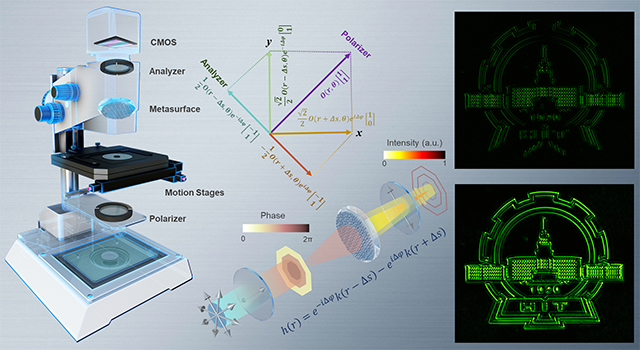In 2023, Professor Ding Xumin’s group from Advanced Microscopy and Instrumentation Research Center, School of Instrumentation Science and Engineering published a research paper titled “Single-shot isotropic differential interference contrast microscopy” in Nature Communications.
DIC microscopy can record phase variations induced by the lateral shear between two orthogonally polarized lights to recover fine details, featuring the advantages of high contrast, fine spatial resolution and pseudo-3D relief imaging and free from the halo and shade-off artifacts of phase contrast microscopy. Hence, they are widely used in measuring cellular morphology and segmentation, particle tracking and other applications. However, conventional DIC microscope has strong orientation sensitivity as they rely on Normarski prisms to generate the rectilinear shear between two orthogonal linear polarizations. Hence, the image contrast is created along that direction, but absent in the orthogonal. So far, obtaining a single-shot isotropic DIC microscopy for fast phase imaging remains a critical challenge, due to the limited functionalities of conventional optical elements.
In order to address these issues, the researchers theoretically proposed and experimentally demonstrated a ultracompact single-shot isotropic differential interference contrast microscopy (i-DIC) to overcome orientation sensitivity of conventional DIC microscopy by exploiting the nontrivial independent phase modulation of two orthogonal polarization states to apply the desired rotationally symmetric shear along radial directions in polar instead of Cartesian coordinate. To showcase the unique capability of metasurface-assisted i-DIC, the direct real-time tracking of microparticles were realized in the background of strong scatterings, which might be applied in studying dynamics of biomolecules in complex cellular environments for targeted drug delivery and others. Furthermore, the i-DIC is employed to capture breast cancer cells and tissues and demonstrate superior performance with much sharper images, which fuses meta-optics with cancer screening and diagnosis and other bio-applications.
This work could show the impressive performance of single-shot, isotropic, highly flexible, phase-based optical imaging capability using only a single metasurface. The work unveils numerous opportunities in high-contrast biological imaging, particle tracking and other technologies, which may serve as an add-on compact module to be easily integrated in the existing imaging system.
This work was financially supported by the National Key R&D Program of China and National Natural Science Foundation of China
Reference
Xinwei Wang, Hao Wang, Jinlu Wang, Xingsi Liu, Huijie Hao, You Sin Tan, Yilei Zhang, He Zhang, Xiangyan Ding, Weisong Zhao, Yuhang Wang, Zhengang Lu, Jian Liu, Joel K.W. Yang, Jiubin Tan, Haoyu Li, Cheng-Wei Qiu, Guangwei Hu, Xumin Ding. Single-shot isotropic differential interference contrast microscopy. Nature Communications, 2023, 14, 2063. DOI:10.1038/s41467-023-37606-6.

Single-shot isotropic differential interference contrast microscopy


